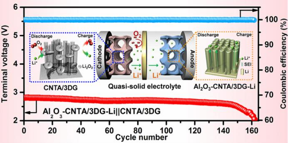Home > Press > Lithiophilic seeds and rigid arrays synergistic induced dendrite-free and stable Li anode towards long-life lithium-oxygen batteries
 |
| The enhanced lithiophilic properties and the rigid array structure of Al2O3-CNTA/3DG synergistically induce dendrite-free and stable Li anode. The LOBs full battery assembled with the Al2O3-CNTA/3DG-Li anode and CNTA/3DG cathode achieves a long-term cycling stability. CREDIT Journal of Energy Chemistry |
Abstract:
Recently, Dr. Yue Li and co-workers (from Tianjin University) prepared lithiophilic aluminum oxide (Al2O3) seeds induced rigid carbon nanotube arrays/three-dimensional graphene (Al2O3-CNTA/3DG) as an effective host material for the Li anode of lithium-oxygen batteries (LOBs). It was found that the Al2O3 nanoparticles greatly enhanced the rigidity of CNTA, yielding significant inhibition of Li dendrite growth. Additionally, lithiophilic Al2O3 nanoparticles reacted with Li+ to form LiAlO2 nanoparticles, which facilitated Li+ transport and stabilized the solid electrolyte interphase (SEI) film. Finally, the LOB assembled with the Al2O3-CNTA/3DG-Li anode and CNTA/3DG cathode exhibited enhanced redox kinetics and could be stably cycled 160 times at a current density of 100 mA g-1 and limited capacity of 500 mAh g-1. This work provided a new strategy for solving the issues of Li dendrite growth and short cycling life for LOBs.
Lithiophilic seeds and rigid arrays synergistic induced dendrite-free and stable Li anode towards long-life lithium-oxygen batteries
Dalian, China | Posted on July 22nd, 2022
This work was published in the Journal of Energy Chemistry as a research article entitled “Lithiophilic seeds and rigid arrays synergistic induced dendrite-free and stable Li anode towards long-life lithium-oxygen batteries”.
####
About Dalian Institute of Chemical Physics, Chinese Academy Sciences
The Journal of Energy Chemistry is a publication that mainly reports on creative researches and innovativeapplications of chemical conversions of fossil energy, carbon dioxide, electrochemical energy and hydrogen energy,as well as the conversions of biomass and solar energy related with chemical issues to promote academicexchanges in the field of energy chemistry and to accelerate the exploration, research and development of energyscience and technologies.
For more information, please click here
Contacts:
Xiaoluan Wei
Dalian Institute of Chemical Physics, Chinese Academy Sciences
Office: 86-041-184-379-021
Copyright © Dalian Institute of Chemical Physics, Chinese Academy Sciences
If you have a comment, please Contact us.
Issuers of news releases, not 7th Wave, Inc. or Nanotechnology Now, are solely responsible for the accuracy of the content.
| Related Links |
| Related News Press |
News and information
![]()
Generating power where seawater and river water meet July 22nd, 2022
![]()
First electric nanomotor made from DNA material: Synthetic rotary motors at the nanoscale perform mechanical work July 22nd, 2022
Possible Futures
![]()
Generating power where seawater and river water meet July 22nd, 2022
![]()
First electric nanomotor made from DNA material: Synthetic rotary motors at the nanoscale perform mechanical work July 22nd, 2022
Discoveries
![]()
HKU physicists found signatures of highly entangled quantum matter July 22nd, 2022
![]()
Buckyballs on gold are less exotic than graphene July 22nd, 2022
Announcements
![]()
Quantum computer works with more than zero and one: Quantum digits unlock more computational power with fewer quantum particles July 22nd, 2022
![]()
Generating power where seawater and river water meet July 22nd, 2022
![]()
First electric nanomotor made from DNA material: Synthetic rotary motors at the nanoscale perform mechanical work July 22nd, 2022
Interviews/Book Reviews/Essays/Reports/Podcasts/Journals/White papers/Posters
![]()
Buckyballs on gold are less exotic than graphene July 22nd, 2022
![]()
Quantum computer works with more than zero and one: Quantum digits unlock more computational power with fewer quantum particles July 22nd, 2022
![]()
Generating power where seawater and river water meet July 22nd, 2022
Automotive/Transportation
![]()
A novel graphene based NiSe2 nanocrystalline array for efficient hydrogen evolution reaction July 15th, 2022
![]()
OCSiAl expands its graphene nanotube production capacities to Europe June 17th, 2022
![]()
A sunlight-driven “self-healing” anti-corrosion coating May 27th, 2022
Battery Technology/Capacitors/Generators/Piezoelectrics/Thermoelectrics/Energy storage
![]()
Crystal phase engineering offers glimpse of future potential, researchers say July 15th, 2022
![]()
Sieving carbons: Ideal anodes for high-energy sodium-ion batteries July 1st, 2022
![]()
Two opposing approaches could give lithium-sulfur batteries a leg up over lithium-ion July 1st, 2022
![]()
Solving the solar energy storage problem with rechargeable batteries that can convert and store energy at once June 24th, 2022












